Additive Manufacturing and Characterization of Metal Particulate Reinforced Polylactic Acid (PLA) Polymer Composites
Abstract
:1. Introduction
2. Materials and Methods
3. Results and Discussions
3.1. Material Characterization
3.2. Mechanical Properties
4. Conclusions
Author Contributions
Funding
Institutional Review Board Statement
Informed Consent Statement
Data Availability Statement
Acknowledgments
Conflicts of Interest
References
- Liu, Z.; Wang, Y.; Wu, B.; Cui, C.; Guo, Y.; Yan, C. A critical review of fused deposition modeling 3-D printing technology in manufacturing polylactic acid parts. Int. J. Adv. Manuf. Technol. 2019, 102, 2877–2889. [Google Scholar] [CrossRef]
- Mohammed, J.S. Applications of 3-D printing technologies in oceanography. Methods Oceanogr. 2016, 17, 97–117. [Google Scholar] [CrossRef]
- Balasubramanian, K.; Tirumali, M.; Badhe, Y.; Mahajan, R.Y. Nano-enabled Multifunctional Materials for Aerospace Applications. In Aerospace Materials and Material Technologies; Prasad, N., Wanhill, P., Eds.; Springer: Singapore, 2016; pp. 439–453. [Google Scholar]
- Baur, J.; Silverman, E. Challenges and opportunities in multifunctional nanocomposite structures for aerospace applications. MRS Bull. 2011, 32, 328–334. [Google Scholar] [CrossRef]
- Gibson, R.F. A review of recent research on mechanics of multifunctional composite materials and structures. Compos. Struct. 2010, 92, 2793–2810. [Google Scholar] [CrossRef]
- Daminabo, C.S.; Goel, S.; Grammatikos, S.A.; Nezhad, H.Y.; Thakur, V.K. Fused deposition modeling-based additive manufacturing (3-D printing): Techniques for polymer material systems. Mater. Today Chem. 2020, 16, 100248. [Google Scholar] [CrossRef]
- Solomon, I.J.; Sevvel, P.; Gunasekaran, J. A Review on the Various Processing Parameters in FDM. Mater. Today Proc. 2021, 37, 509–514. [Google Scholar] [CrossRef]
- Mohd Pu’ad, A.S.; Abdul Haq, R.H.; Mohd Noh, H.; Abdullah, H.Z.; Idris, M.I.; Lee, T.C. Review on the Fabrication of Fused Deposition Modelling (FDM) Composite Filament for Biomedical Applications. Mater. Today: Proc. 2020, 29, 228–232. [Google Scholar] [CrossRef]
- Tymrak, B.M.; Kreiger, M.; Pearce, J.M. Mechanical properties of components fabricated with open-source 3-D printers under realistic environmental conditions. Mater. Des. 2014, 58, 242–246. [Google Scholar] [CrossRef] [Green Version]
- Wittbrodt, B.T.; Glover, A.G.; Laureto, J.; Anzalone, G.C.; Oppliger, D.; Irwin, J.L.; Pearce, J.M. Life-cycle economic analysis of distributed manufacturing with open-source 3-D printers. Mechatronics 2013, 23, 713–726. [Google Scholar] [CrossRef] [Green Version]
- Kreiger, M.; Pearce, J.M. Environmental life cycle analysis of distributed 3-D printing and conventional manufacturing of polymer products. ACS Sustain. Chem. Eng. 2013, 1, 1511–1519. [Google Scholar] [CrossRef]
- Despeisse, M.; Baumers, M.; Brown, P.; Charnley, F.; Ford, S.J.; Garmulewicz, A.; Knowles, S.; Minshall, T.H.W.; Mortara, L.; Reed-Tsochas, F.P.; et al. Unlocking value for a circular economy through 3-D printing: A research agenda. Technol. Forecast. Soc. Chang. 2017, 115, 75–84. [Google Scholar] [CrossRef] [Green Version]
- Montjovent, M.O.; Mark, S.; Mathieu, L.; Scaletta, C.; Scherberich, A.; Delabarde, C.; Zambelli, P.Y.; Bourban, P.E.; Apple-gate, L.A.; Pioletti, D.P. Human fetal bone cells associated with ceramic reinforced PLA scaffolds for tissue engineering. Bone 2008, 42, 554–564. [Google Scholar] [CrossRef] [PubMed] [Green Version]
- Namiki, M.; Ueda, M.; Todoroki, A.; Hirano, Y.; Matsuzaki, R. 3-D Printing of Continuous Fiber Reinforced Plastic. In Proceedings of the SAMPE Seattle 2014 International Conference and Exhibition, Seattle, DC, USA, 6 February 2014. [Google Scholar]
- Li, N.; Li, Y.; Liu, S. Rapid prototyping of continuous carbon fiber reinforced polylactic acid composites by 3-D printing. J. Mater. Process. Tech. 2016, 238, 218–225. [Google Scholar] [CrossRef]
- Bettini, P.; Alitta, G.; Sala, G.; Di Landro, L. Fused deposition technique for continuous fiber reinforced thermoplastic. J. Mater. Eng. Perform. 2017, 26, 843–848. [Google Scholar] [CrossRef]
- Dickson, A.N.; Barry, J.N.; McDonnell, K.A.; Dowling, D.P. Fabrication of continuous carbon, glass and Kevlar fibre reinforced polymer composites using additive manufacturing. Addit. Manuf. 2017, 16, 146–152. [Google Scholar] [CrossRef]
- Tian, X.; Liu, T.; Wang, Q.; Dilmurat, A.; Li, D.; Ziegmann, G. Recycling and remanufacturing of 3-D printed continuous carbon fiber reinforced PLA composites. J. Clean. Prod. 2017, 142, 1609–1618. [Google Scholar] [CrossRef]
- Yao, X.; Luan, C.; Zhang, D.; Lan, L.; Fu, J. Evaluation of carbon fiber-embedded 3-D printed structures for strengthening and structural-health monitoring. Mater. Des. 2017, 114, 424–432. [Google Scholar] [CrossRef]
- Matsuzaki, R.; Ueda, M.; Namiki, M.; Jeong, T.K.; Asahara, H.; Horiguchi, K.; Nakamura, T.; Todoroki, A.; Hirano, Y. Three-dimensional printing of continuous-fiber composites by in-nozzle impregnation. Sci. Rep. 2016, 6, 23058. [Google Scholar] [CrossRef] [PubMed]
- Melenka, G.W.; Cheung, B.K.; Schofield, J.S.; Dawson, M.R.; Carey, J.P. Evaluation and prediction of the tensile properties of continuous fiber-reinforced 3-D printed structures. Compos. Struct. 2016, 153, 866–875. [Google Scholar] [CrossRef]
- Parandoush, P.; Tucker, L.; Zhou, C.; Lin, D. Laser assisted additive manufacturing of continuous fiber reinforced thermoplastic composites. Mater. Des. 2017, 131, 186–195. [Google Scholar] [CrossRef]
- Fafenrot, S.; Grimmelsmann, N.; Wortmann, M.; Ehrmann, A. Three-dimensional (3-D) printing of polymer-metal hybrid materials by fused deposition modeling. Materials 2017, 10, 1199. [Google Scholar] [CrossRef] [Green Version]
- Hamidi, A.; Tadesse, Y. Single step 3-D printing of bioinspired structures via metal-reinforced thermoplastic and highly stretchable elastomer. Compos. Struct. 2019, 210, 250–261. [Google Scholar] [CrossRef]
- Liu, Z.; Lei, Q.; Xing, S. Mechanical characteristics of wood, ceramic, metal and carbon fiber-based PLA composites fabricated by FDM. J. Mater. Res. Tech. 2019, 8, 3741–3751. [Google Scholar] [CrossRef]
- Salea, A.; Prathumwan, R.; Junpha, J.; Subannajui, K. Metal oxide semiconductor 3-D printing: Preparation of copper(ii) oxide by fused deposition modelling for multi-functional semiconducting applications. J. Mater. Chem. C 2017, 5, 4614–4620. [Google Scholar] [CrossRef]
- Horst, D.J.; Tebcherani, S.M.; Kubaski, E.T.; de Almeida Vieira, R. Bioactive potential of 3-D-printed oleo-gum-resin disks: B. papyrifera, C. myrrha, and S. benzoin loading nanooxides—TiO2, P25, Cu2O, and MoO3. Hindawi Bioinorg. Chem. Appl. 2017, 6398167. [Google Scholar]
- Ahn, B.Y.; Walker, S.B.; Slimmer, S.C.; Russo, A.; Gupta, A.; Kranz, S.; Duoss, E.B.; Malkowski, T.F.; Lewis, J.A. Planar and three-dimensional printing of conductive inks. J. Vis. Exp. 2011, 58, e3189. [Google Scholar] [CrossRef] [PubMed]
- Russo, A.; Ahn, B.Y.; Adams, J.J.; Duoss, E.B.; Bernhard, J.T.; Lewis, J.A. Pen-on-paper flexible electronics. Adv. Mater. 2011, 23, 3426–3430. [Google Scholar] [CrossRef] [PubMed]
- Grimmelsmann, N.; Martens, Y.; Schäl, P.; Meissner, H.; Ehrmann, A. Mechanical and electrical contacting of electronic components on textiles by 3-D printing. Procedia Technol. 2016, 26, 66–71. [Google Scholar] [CrossRef] [Green Version]
- ASTM D638-14. Standard Test Method for Tensile Properties of Plastics; ASTM International: West Conshohocken, PA, USA, 2014. [Google Scholar]
- ASTM C1259-15. Standard Test Method for Dynamic Young’s Modulus, Shear Modulus, and Poisson’s Ratio for Advanced Ceramics by Impulse Excitation of Vibration; ASTM International: West Conshohocken, PA, USA, 2015. [Google Scholar]
- ASTM D5045-14. Standard Test Methods for Plane-Strain Fracture Toughness and Strain Energy Release Rate of Plastic Materials; ASTM International: West Conshohocken, PA, USA, 2014. [Google Scholar]
- Kamran, M.; Saxena, A. A comprehensive study on 3-D printing technology. MIT Inter. J. Mech. Eng. 2016, 6, 63–69. [Google Scholar]
- Spoerk, M.; Holzer, C.; Gonzalez-Gutierrez, J. Material extrusion-based additive manufacturing of polypropylene: A review on how to improve dimensional inaccuracy and warpage. J. Appl. Polym. Sci. 2019, 137, 48545. [Google Scholar] [CrossRef]
- Gupta, S.; Halbig, M.C.; Singh, M. Particulate reinforced polymer matrix composites: Tribological behavior and 3-D printing by fused filament fabrication. Adv. Mater. Process. 2020, 178, 12–18. [Google Scholar]
- Salem, A.; Singh, M.; Halbig, M.C. 3-D printing and characterization of polymer composites with different reinforcements. In Advanced Processing and Manufacturing Technologies for Nanostructured and Multifunctional Materials II: A Collection of Papers Presented at the 39th International Conference on Advanced Ceramics and Composites; Ohji, T., Singh, M., Halbig, M., Eds.; John Wiley & Sons, Inc.: Hoboken, NJ, USA, 2015; pp. 113–122. [Google Scholar]
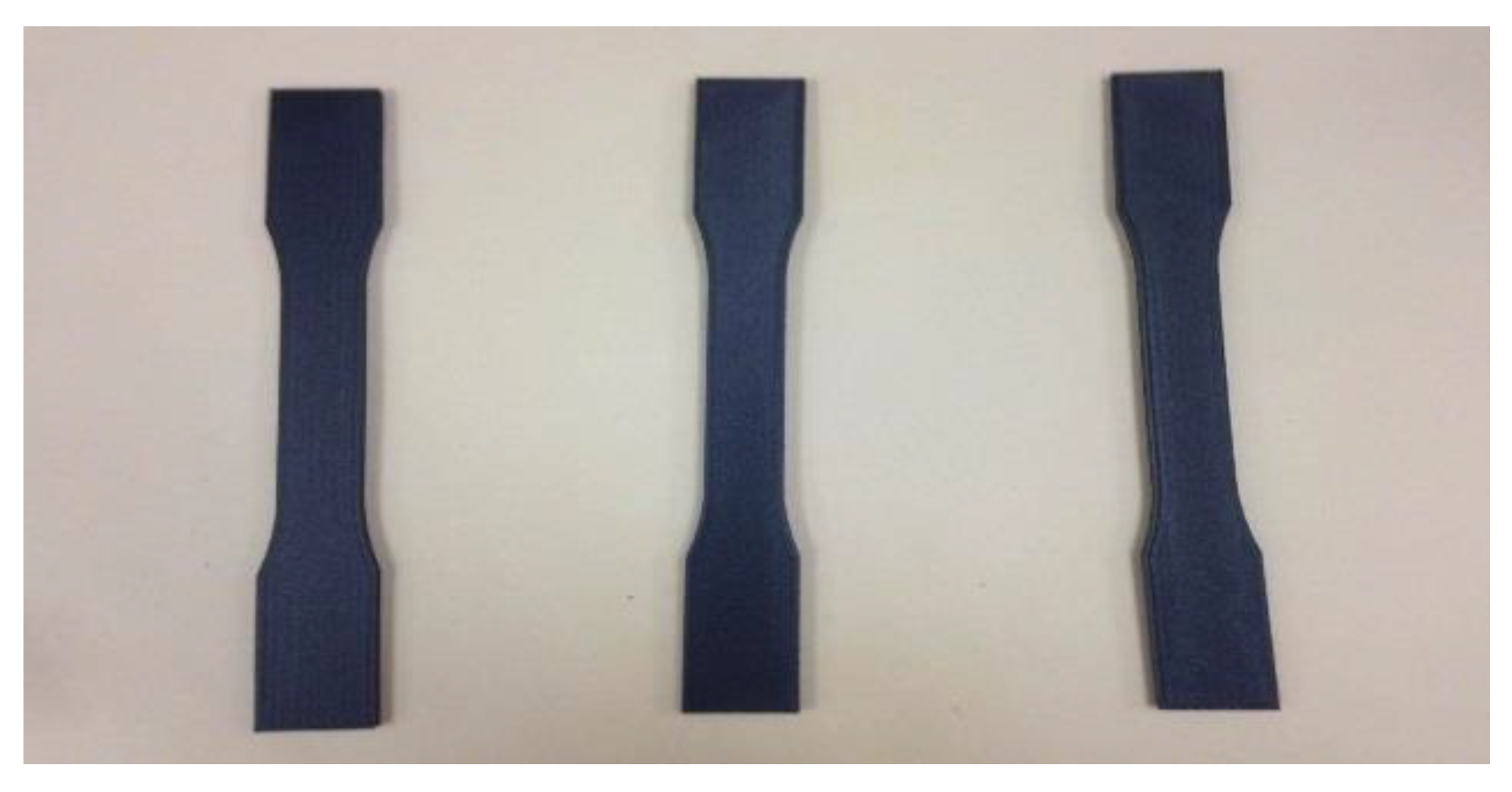
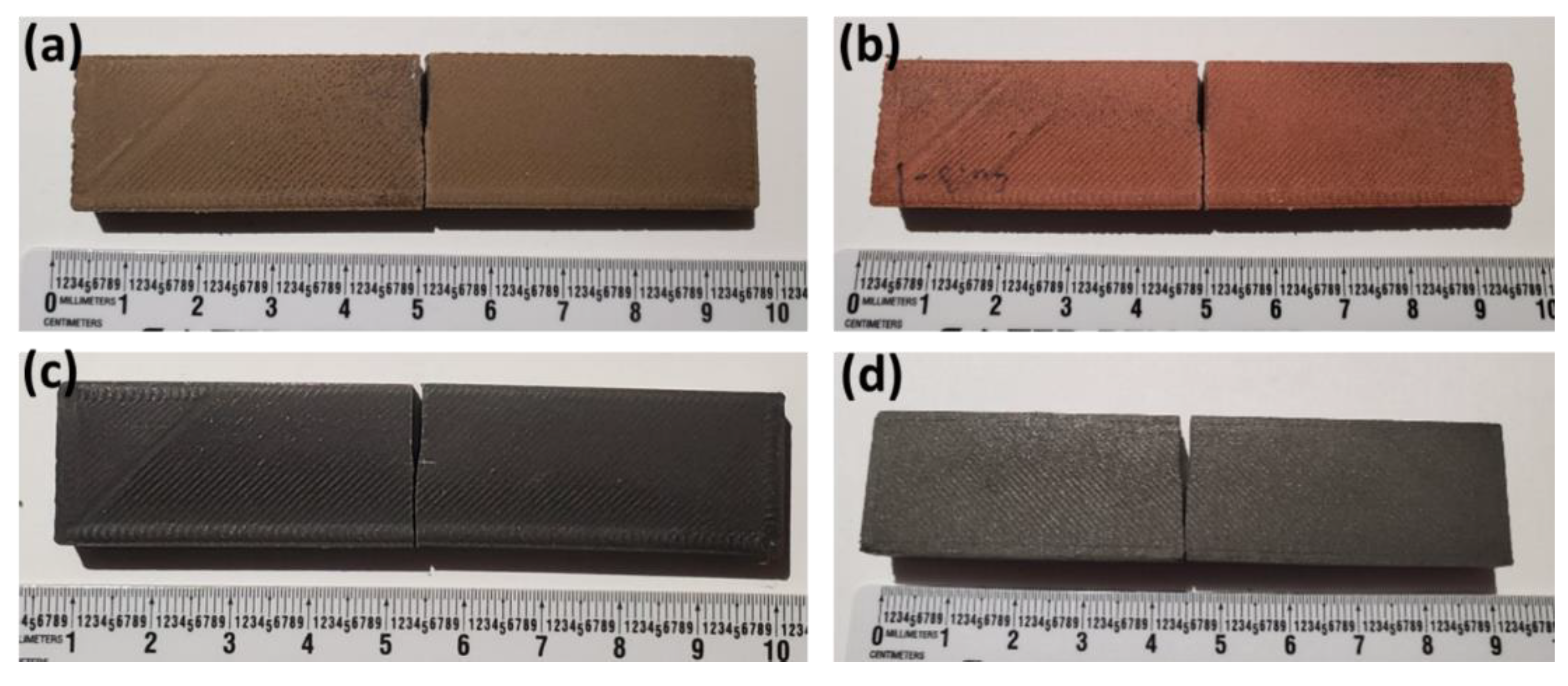
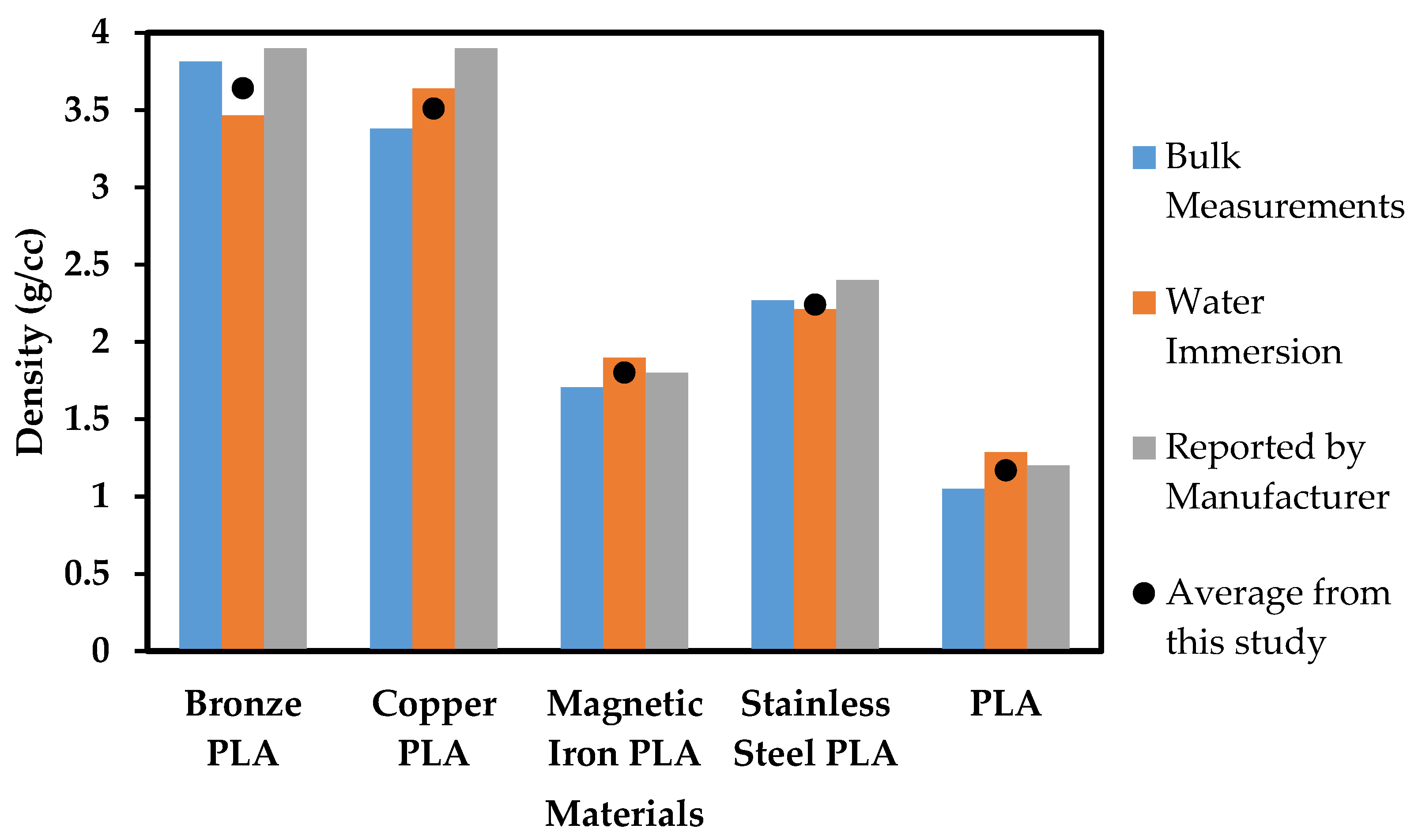
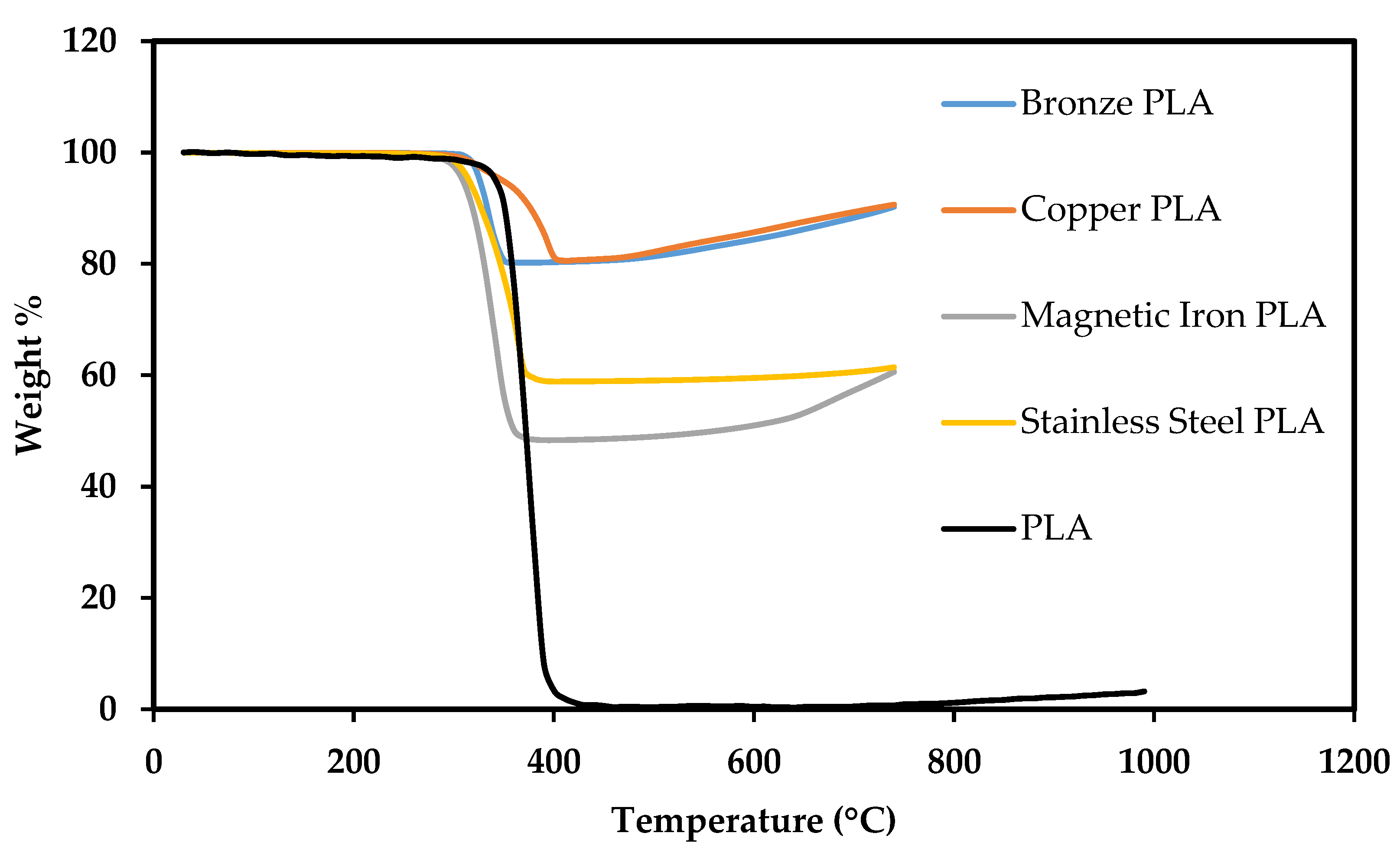
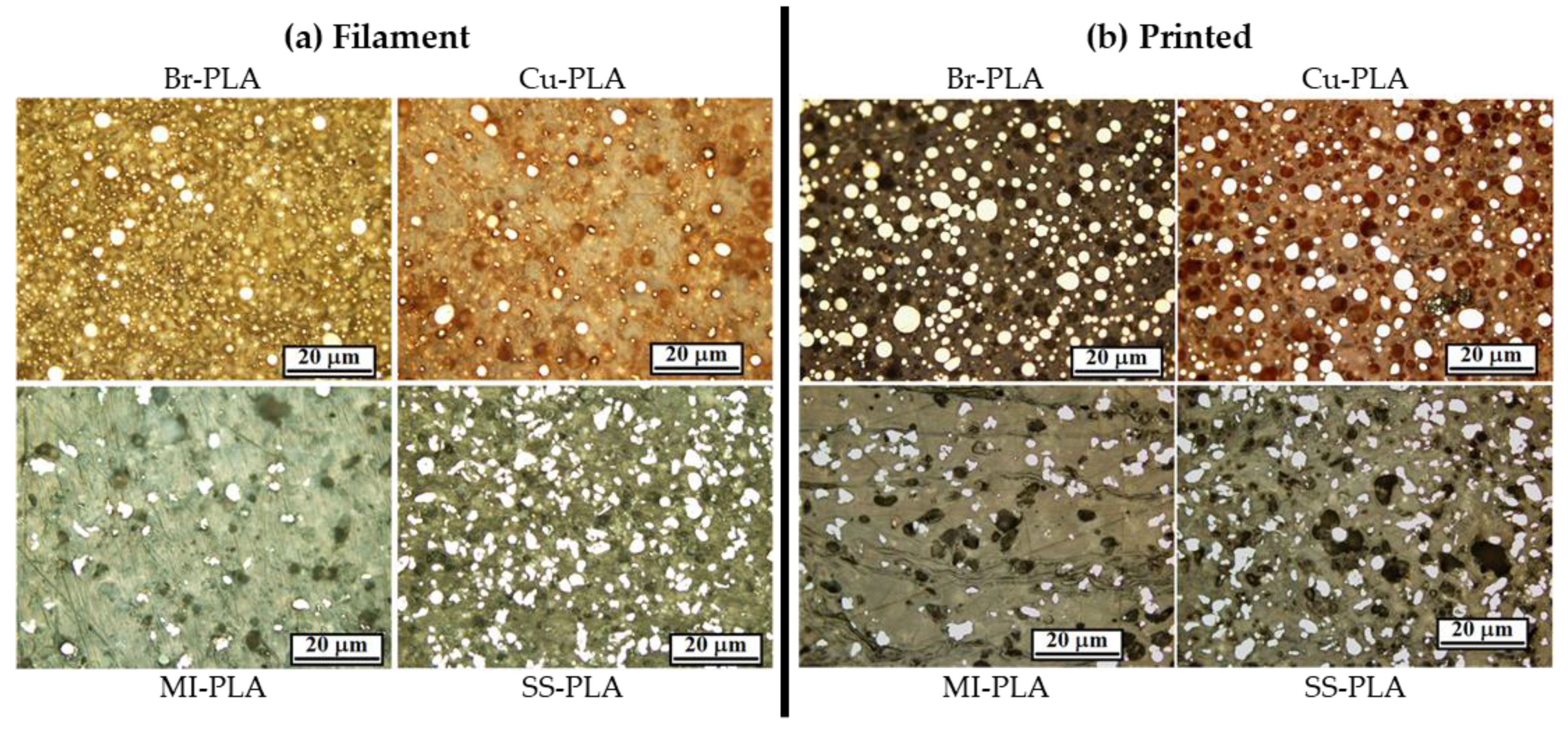


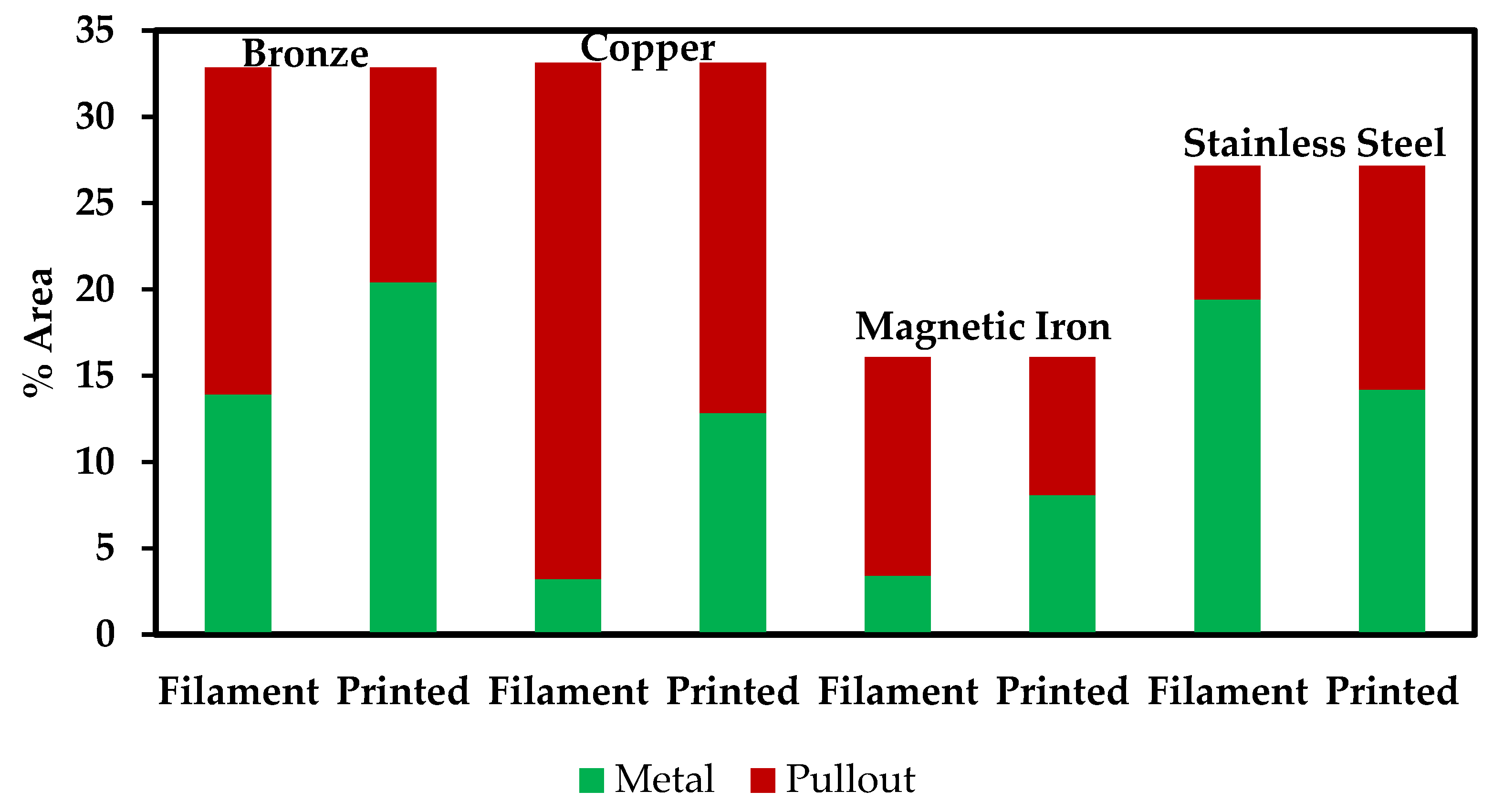
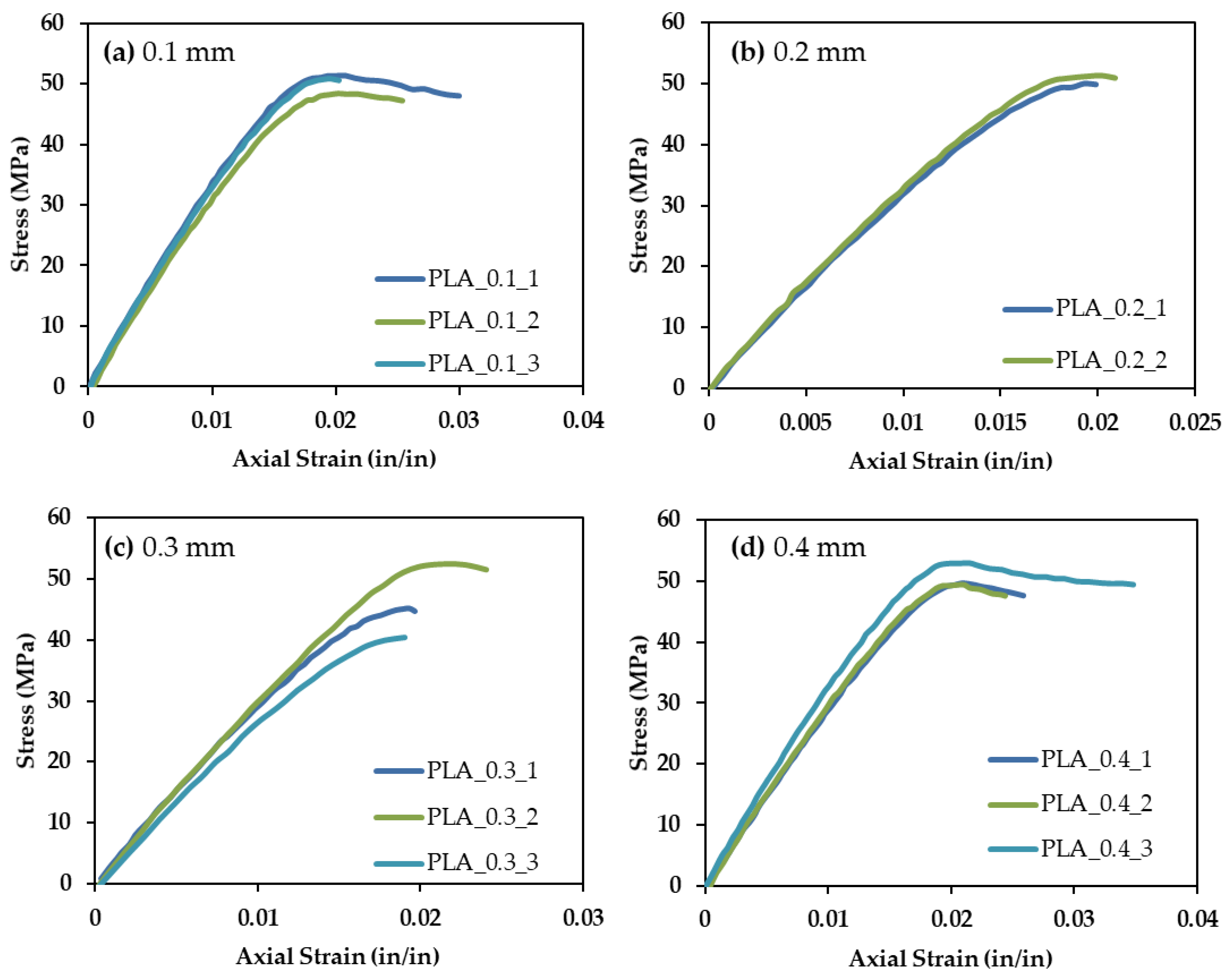
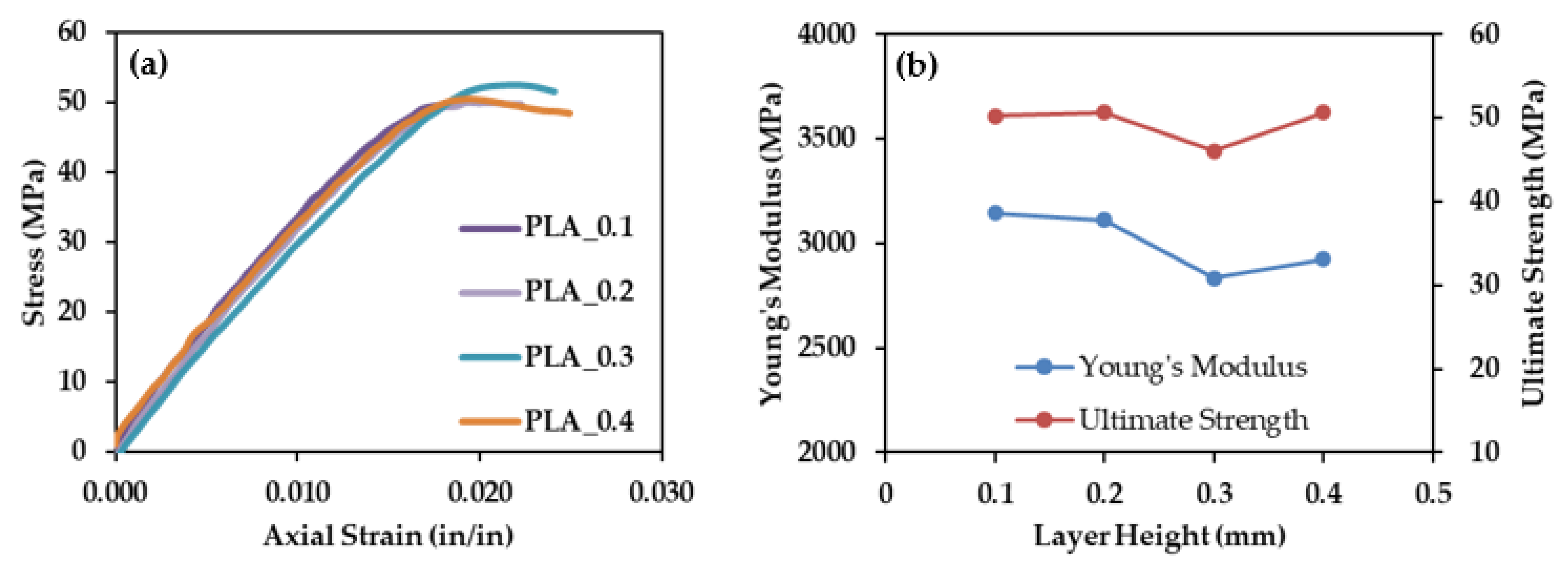
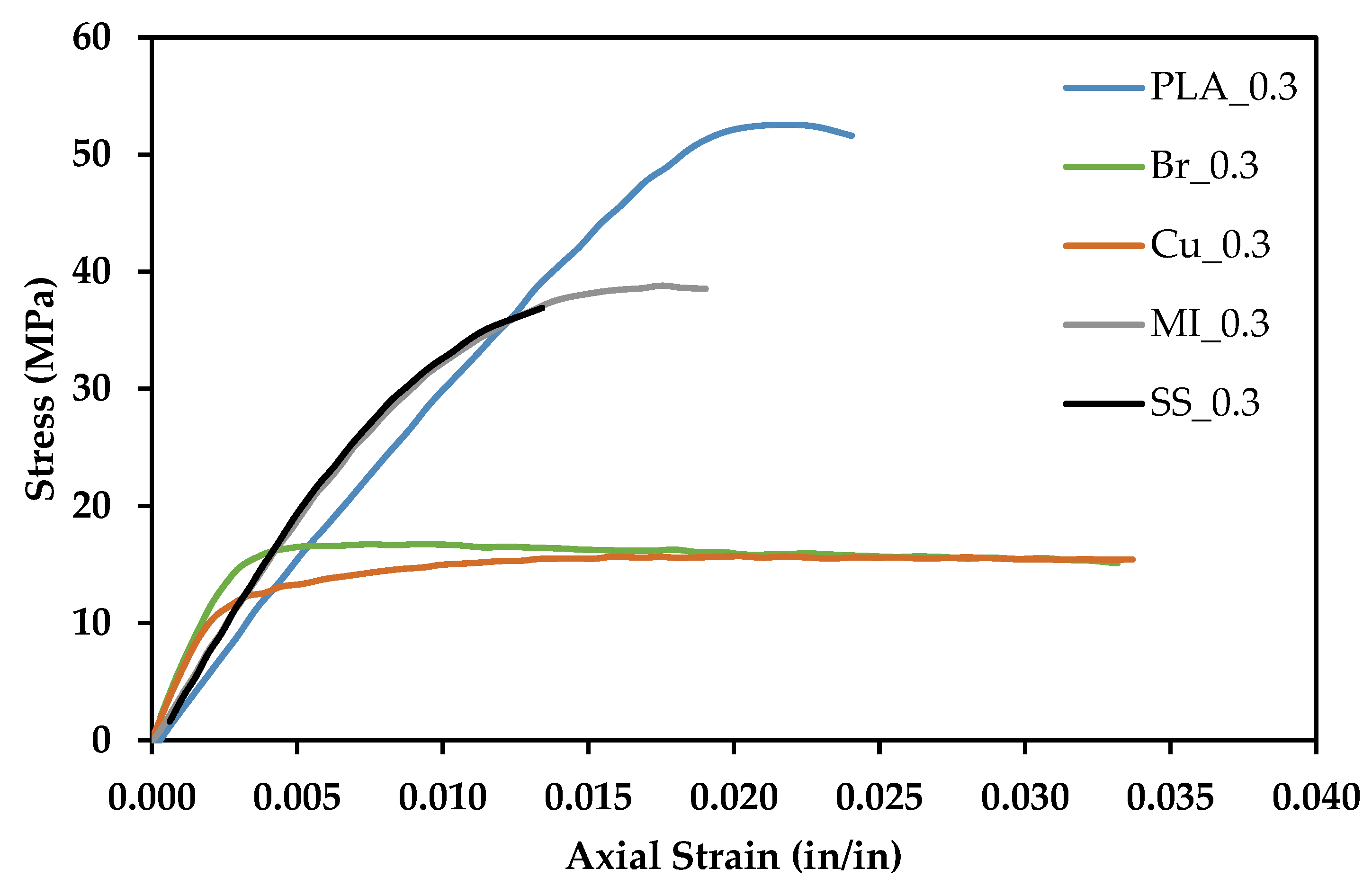
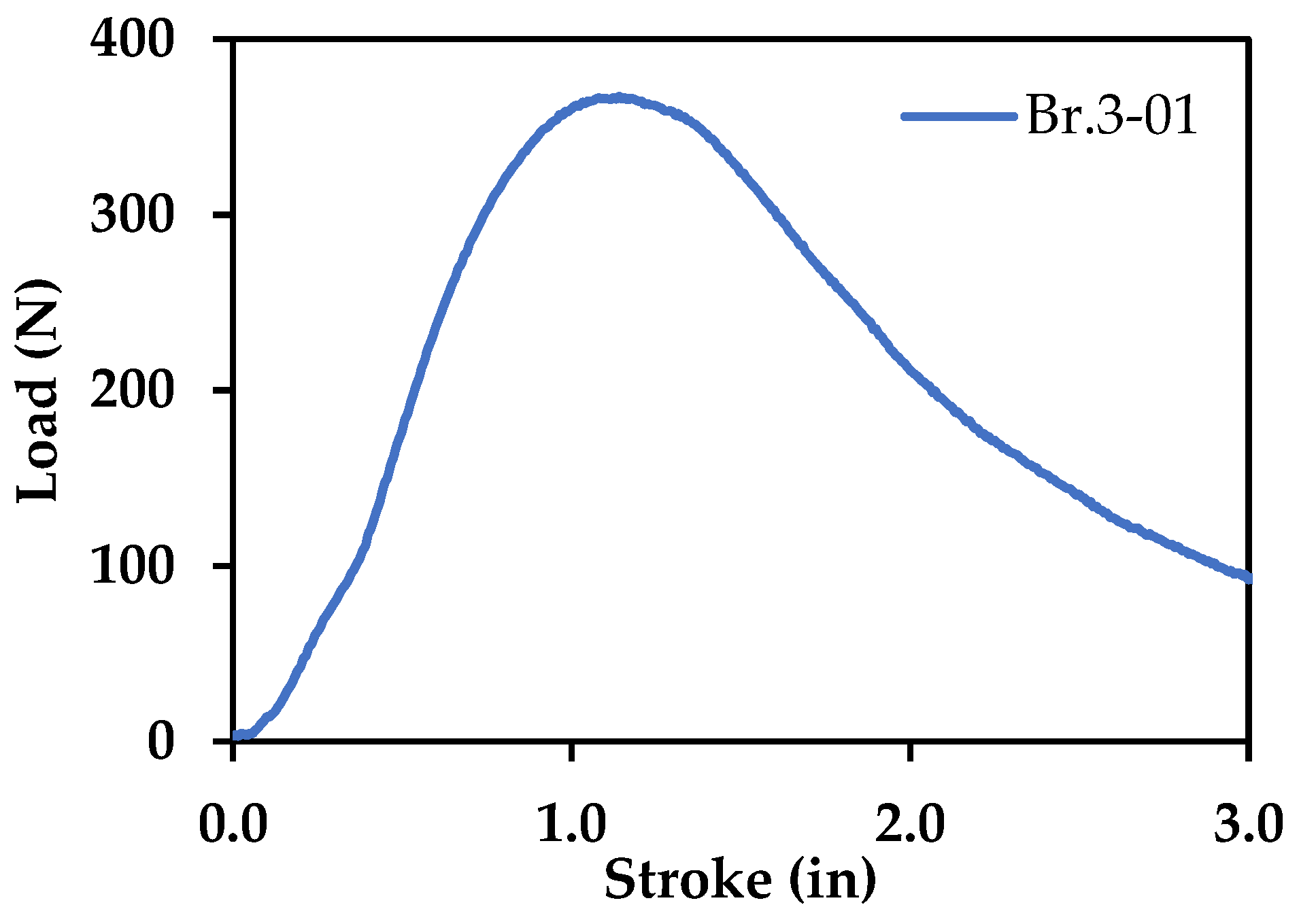

| Material | Metal wt% | Metal vol% |
|---|---|---|
| Br-PLA | 80.35% | 36.02% |
| Cu-PLA | 80.57% | 36.41% |
| MI-PLA | 48.33% | 11.05% |
| SS-PLA | 58.87% | 18.09% |
| PLA | 0.00% | 0.00% |
| Material | Metal Area% | Pullout Area% | Total Area% |
|---|---|---|---|
| Br-Filament | 13.9% | N/A | 13.9% |
| Br-Printed | 20.4% | 12.5% | 32.9% |
| Cu-Filament | 3.2% | 10.6% | 13.8% |
| Cu-Printed | 12.9% | 20.3% | 33.2% |
| MI-Filament | 3.4% | 4.1% | 7.5% |
| MI-Printed | 8.1% | 8.0% | 16.1% |
| SS-Filament | 19.4% | 2.1% | 21.5% |
| SS-Printed | 14.2% | 13.0% | 27.2% |
| Material | Metal Area% | Pullout Area% | Total Area% | Metal Vol% (TGA) |
|---|---|---|---|---|
| Br-Filament | 13.9% | 19.0% * | 36.02% | |
| Br-Printed | 20.4% | 12.5% | 32.9% | |
| Cu-Filament | 3.2% | 30.0% * | 36.41% | |
| Cu-Printed | 12.9% | 20.3% | 33.2% | |
| MI-Filament | 3.4% | 12.7% * | 11.05% | |
| MI-Printed | 8.1% | 8.0% | 16.1% | |
| SS-Filament | 19.4% | 7.8% * | 18.09% | |
| SS-Printed | 14.2% | 13.0% | 27.2% |
| Material | Young’s Modulus (MPa) | Ultimate Strength (MPa) | Poisson’s Ratio | Fracture Toughness (MPa√m) |
|---|---|---|---|---|
| Br-PLA (0.3 mm) | 5401 | 17 | 0.29 | 2.0 |
| Cu-PLA (0.3 mm) | 4496 | 16 | 0.25 | 1.7 |
| MI-PLA (0.3 mm) | 3638 | 39 | 0.32 | 3.4 |
| SS-PLA (0.3 mm) | 3910 | 38 | 0.33 | 3.1 |
| PLA (0.1 mm) | 3145 | 50 | 0.33 | N/A |
| PLA (0.2 mm) | 3110 | 51 | 0.34 | N/A |
| PLA (0.3 mm) | 2835 | 46 | 0.33 | 3.39 |
| PLA (0.4 mm) | 2925 | 51 | 0.34 | N/A |
Publisher’s Note: MDPI stays neutral with regard to jurisdictional claims in published maps and institutional affiliations. |
© 2021 by the authors. Licensee MDPI, Basel, Switzerland. This article is an open access article distributed under the terms and conditions of the Creative Commons Attribution (CC BY) license (https://creativecommons.org/licenses/by/4.0/).
Share and Cite
Vakharia, V.S.; Kuentz, L.; Salem, A.; Halbig, M.C.; Salem, J.A.; Singh, M. Additive Manufacturing and Characterization of Metal Particulate Reinforced Polylactic Acid (PLA) Polymer Composites. Polymers 2021, 13, 3545. https://doi.org/10.3390/polym13203545
Vakharia VS, Kuentz L, Salem A, Halbig MC, Salem JA, Singh M. Additive Manufacturing and Characterization of Metal Particulate Reinforced Polylactic Acid (PLA) Polymer Composites. Polymers. 2021; 13(20):3545. https://doi.org/10.3390/polym13203545
Chicago/Turabian StyleVakharia, Ved S., Lily Kuentz, Anton Salem, Michael C. Halbig, Jonathan A. Salem, and Mrityunjay Singh. 2021. "Additive Manufacturing and Characterization of Metal Particulate Reinforced Polylactic Acid (PLA) Polymer Composites" Polymers 13, no. 20: 3545. https://doi.org/10.3390/polym13203545
APA StyleVakharia, V. S., Kuentz, L., Salem, A., Halbig, M. C., Salem, J. A., & Singh, M. (2021). Additive Manufacturing and Characterization of Metal Particulate Reinforced Polylactic Acid (PLA) Polymer Composites. Polymers, 13(20), 3545. https://doi.org/10.3390/polym13203545






